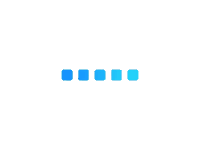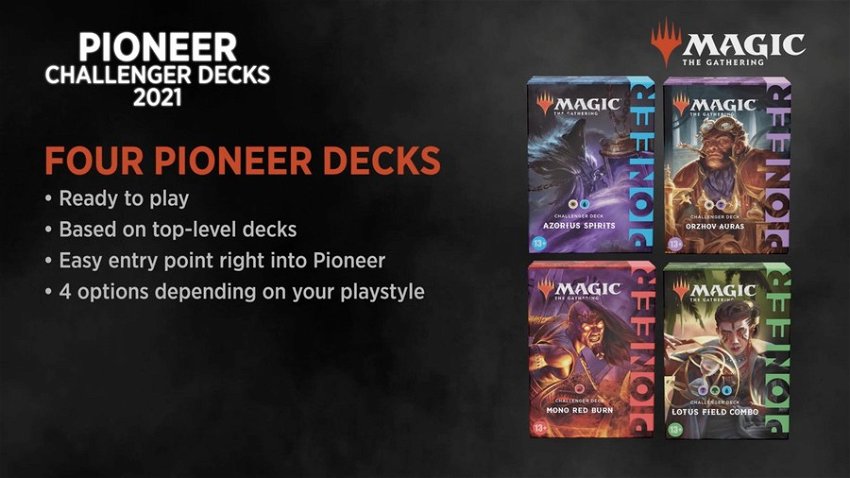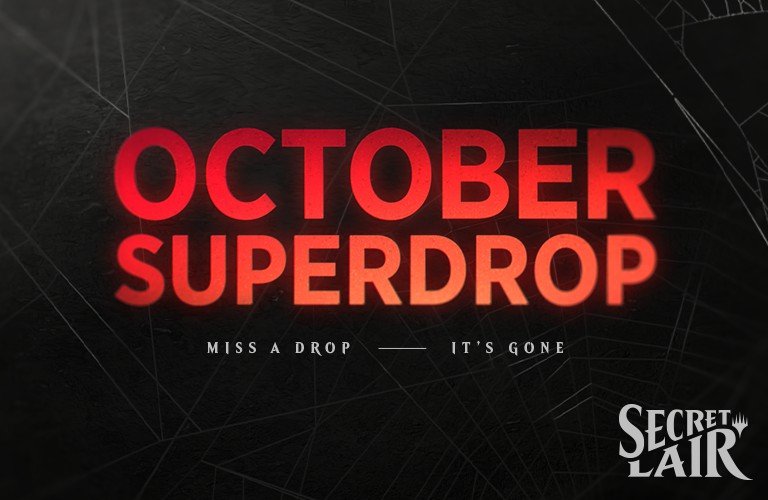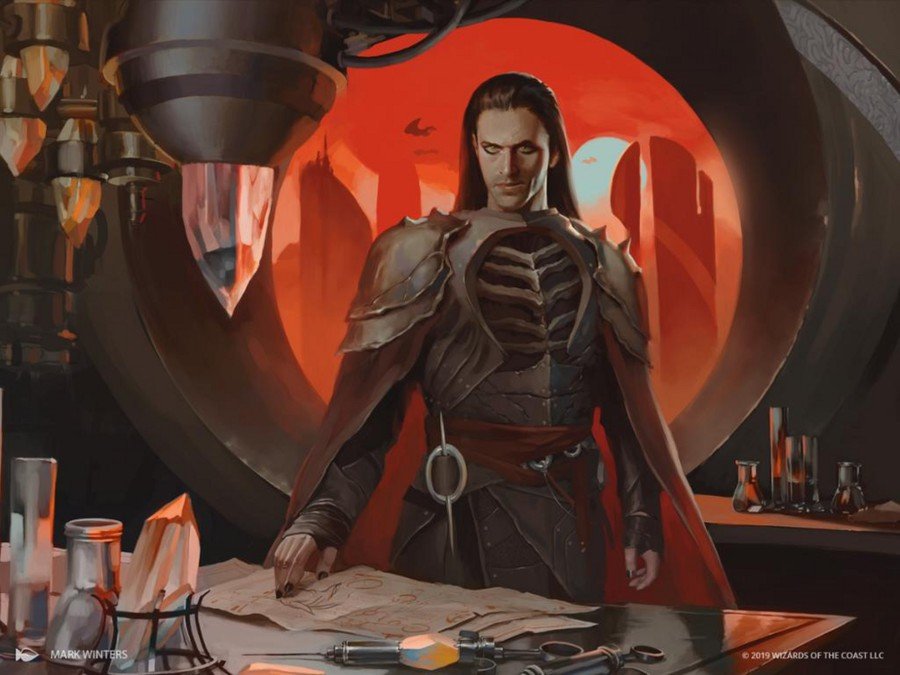This week the Pioneer Challenger Decks were released, and these are four decks built essentially so you can sleeve them up and play them right away at your local store events, much like the Standard Challenger Decks that are released annually.
However, as with any competitive-oriented product, its lists are not usually complete and closed, but they usually provide a good basis to be played immediately, while also offering space for the player to exercise their creativity or decide to invest in a 100% competitive version of them.
Therefore, in this article I intend to explore and elaborate on possible ways to improve each of the decks: Azorius Spirits, Mono-Red Aggro, Orzhov Auras and Lotus Combo, as well as explaining how each list works, comment on their gameplay value straight out of the box and evaluating, at the end, which decks are most worth buying in gameplay terms.
It is worth noting that, in the case of some decks, I will first try to make an improvement based on the strategy proposed by the closed product before moving on to the most competitive version as possible, since I believe that, in this way, the player who acquires it can make a “ladder” between the box version, an intermediate version, and the most competitive version possible that the proposed product can get.
Azorius Spirits
Azorius Spirits essentially functions as a Tempo Deck, which aims to advance its evasive creatures while delaying the opponent's game by responding to their cards with counterspells like Lofty Denial or cards that perform relevant effects while also being creatures, like Spell Queller. It bets on the tribal synergy that Spirits and/or flying creatures have thanks to Supreme Phantom and Empyreal Eagle to speed up the clock and end the game quickly.
This is the deck for players who like to have a proactive plan, but don't want to completely give up interaction against the opponent, having cards that work on both occasions, while the tribal synergy certainly attracts casual players to this list as well.
However, out of the four, this is the one I would least recommend to a new player. First, because a deck like Spirits is not simple to play and is too punishing to be used in an unpretentious way and without a careful planning, and besides, this is by far the worst deck for pick-and-play.
Starting with the lands, the list has two copies of Glacial Fortess and four copies of Temple of Enlightenment, and while manafixing and scry are useful, a Tempo deck like Spirits which has a crescent curve, definitely cannot afford to play lands that enters tapped unconditionally, as it is extremely punitive to the player, as a tapped land on turn 3 can mean not being able to counter the opponent's key card with Spell Queller, for example.
Going to the creatures, the list has very strange numbers of its main cards: two copies of Spell Queller and Mausoleum Wanderer, plus one copy of Selfless Spirit are very questionable numbers to make it functional even if played against the other three products, straight out of the box. It's like this deck was built so you need to buy two of them to start playing.
Finally, the sideboard has an equally strange mix of cards, but all are relatively understandable given that these products were not built to be fully complete, although I still consider that there are better options that could be applied, such as an increase in the number of Devout Decree.
In summary, Azorius Spirits, despite being attractive and with a good strategy, seems too incomplete to be played straight out of the box because its structure has too few copies of essential cards and its manabase is pretty bad for a Tempo deck.
So, how can we improve it?
Initially, I will focus on the Azorius version, as the proposed strategy straight out-of-the-box lies in this combination and manabase. Therefore, the investment needed to improve it will be smaller if we initially keep it in the Azorius base and, for that, I created a list strongly inspired by the one used by the player Bandit Keith, who is commonly in the Top 4 of Pioneer Royale.

The deck needs four copies of its main cards, that's obvious, and there shouldn't be as many 2-ofs in the original list. The only exception is Selfless Spirit, which you can use 2 or 3 copies in Maindeck, depending on your local Metagame.

The other mandatory change to the Challenger Deck list is a manabase upgrade, and don't be afraid to invest in lands, as they will always come in handy, even if you decide to change decks.
Hallowed Fountain can enter untapped at any stage of the game while interacting very well with Glacial Fortress.
Hengegate Pathway is another of the best allied color duals we have in Pioneer these days, but it should always be used planning ahead for your deck's needs, as when you choose a side, it will only generate mana of one color.
By the way, if the inclusion of Hengegate Pathway makes the budget too heavy, you can use some copies of Port Town as it interacts well with Hallowed Fountain, but be aware that there will be times when you can have a tapped land on unwanted moments.

A very functional card in a creature metagame is Nebelgast Herald, which essentially turns all your Spirits into a sort of disruption to remove blockers or hold the opponent's combat, something that is also done with Shacklegeist.

Although Skyclave Apparition has a high price tag at the moment, it's the best option the archetype has for dealing with a number of problematic permanents, ranging from creatures like Kroxa, Titan of Death's Hunger to Arclight Phoenix, passing through enchanted creatures, some Planeswalkers, among other permanents.
You can replace it with Detention Sphere or Deputy of Detention if you prefer, but Skyclave Apparition is a multi-format staple and is definitely worth the investment.

Settle the Wreckage is very relevant against other creature decks and can turn the game in your favor, as these games commonly act as a race between players, each one trying to slow down the opponent's clock while advancing with yours and in these situations, Settle the Wreckage can end the opponent's clock for good, putting them way behind in the match.
Moving on to its more competitive version, Bant Spirits essentially uses the same base as Azorius Spirits, but includes a green splash for a card that makes a huge difference in the archetype:

Collected Company essentially allows you to put two creatures from your deck into play, at Instant-Speed, which commonly creates both absurdly explosive openings where you win the game the next turn, and also allows the archetype to look for the necessary answer between the top six cards for each situation, either a counterspell, with Spell Queller and Mausoleum Wanderer, or a removal with Skyclave Apparition.

And the cost of this includes significant improvements to the manabase to make access to the card, which becomes the archetype's main pillar, the most feared play by opponents at all stages of the game from turn four onwards.
Looking at today's competitive landscape, Bant Spirits is extremely viable in larger tournaments, being the fourth most played deck of the format today and managing to get results in virtually every Challenge at the moment.
In summary, Azorius Spirits is a pretty bad deck straight out of the box, but it has the potential to be very playable with some light investment where it retains its Azorius base and becomes much more functional and flexible against multiple opponents in a local metagame, and it also becomes one of the best decks of the format today if you decide to invest more and build your Bant version later.
GRADE: 5/10
Mono Red Burn
Mono-Red Burn is, as the name suggests, an Aggro deck whose objective is to bring the opponent's life total to zero in as few turns as possible and, to complete this objective, it has a low-cost creature base that have great synergy with its spells, as Soul-Scar Mage and Monastery Swiftspear grow every time you cast a noncreature spell, while Ghitu Lavarunner becomes an immediate threat when you have two or more Instants or Sorceries in your Graveyard.
In addition, the list also has some reach and impactful plays for later turns, such as Bonecrusher Giant, which can be an early-game removal while also a threat from turn 3 onwards, while Bomat Courier and Light up the Stage allows it to keep the cards running after the first few turns.
Considering the gameplay factor, Mono-Red Burn is the second-best deck to play straight out of the box, as its base is very consistent, its game plan is fast and its main cards are present in the list in abundant quantities, plus archetypes like Mono-Red always have that "free-win" button against unprepared opponents, or punish bad keeps, or heavy mulligans.
Starting to talk about improvements, Mono-Red Aggro is a deck that does some occasional results in Pioneer and, to the players' happiness, a good part of what consists of the main lists are present in the closed product, while the rest are recently released cards, or are likely to become more accessible by being present in the box in small numbers, except for a Born of the Gods staple.
This version above is a blend of the top Mono-Red lists that have made recent results at Pioneer events, with modifications and additions that I particularly find beneficial to its game plan.

Starting with the most expensive card on the list, and one that the deck has absolutely no copies of, Eidolon of the Great Revel is a staple of pretty much all the Pioneer, Modern, or Legacy Burn archetypes, and though it seems counterintuitive for a new player (which I believe contributed to its absence in the product), it makes a huge difference in setting the clock against opponents who cast multiple spells in a turn while also working to attack the opponent.
It's important to point out that, unlike Modern or Legacy, where you usually want to play Eidolon as soon as possible, there is a significant number of times when, because of how game development in the format works, you first need to establish some pressure and/ or board damage advantage before casting it, as you'll usually still have cards to play as the game progresses, and you want to avoid risking ending up falling behind in damage and getting punished by your own creature.
However, where this creature stands out is in less aggressive matches, where the opponent does not usually set a clock fast enough, as is the case with Control decks, or in matchups where the opponent seeks to use multiple spells in a turn, such as against Lotus Combo or the format's current best, Izzet Phoenix.

Den of the Bugbear was a land released recently, in Adventures in the Forgotten Realms, and it fits very well in this archetype to improve its manabase, which now adopts between 22 and 24 lands due to the increase in the curve, while its activated ability allows it to transform into a mini Goblin Rabblemaster, becoming a powerful late game manasink, which puts more pressure on empty boards after a sweeper, for example.

There are very few occasions where Wild Slash will be better than Play With Fire on Pioneer these days, and the Scry 1 offered by the Innistrad: Midnight Hunt addition makes a difference in an archetype that has no means of getting card selection and play with few card advantage features.

Speaking of card advantage, the deck's curve goes up a little with these changes, and cards like Ghitu Lavarunner and Light up the Stage lose some of their utility by reducing the number of direct damage spells and in creatures that play “under” the opponent and, with that, it becomes possible to take better advantage of one of the format's most powerful planeswalker: Chandra, Torch of Defiance.
Players who lived through the days of Standard's Ramunap Red know what I'm talking about: Chandra is card advantage, mana ramp, removal and wincondition all in one card and offers all the reach an aggressive red deck could need to stay in the game and /or play over the "Burn" versions, which tend to play with a greater focus on direct damage.

As the deck now focuses a bit more on playing with impactful threats, Goblin Chainwhirler, who has already set the Standard as well and, just like back when it was a major staple, here it interacts very well with Soul-Scar Mage to deal damage to all opponent's creatures in the form of -1/-1 counters, which makes a big difference in the course of the match and that, added to the 3/3 body with First Strike, makes it a considerable threat to opponents.

There are many cards for the last four slots, such as Kari Zev, Skyship Raider, Torbran, Thane of the Red Fell, Zurgo Bellstriker or Anax, Hardened by the Forge or more damage spells like Wild Slash, but I chose Rimrock Knight because it interacts well with the rest of the list, adding Prowess triggers for Soul-Scar Mage and Monastery Swiftspear, giving a significant power-up to a blocked Goblin Chainwhirler and is a 3/1 creature for two mana on its own, as well as being easy to find and very accessible.

As many cards from the original deck's sideboard go to the Maindeck, several new options come in.
Rampaging Ferocidon is very useful in preventing your opponents from gaining life while setting a clock, and also punishes decks that manages to play or create various creatures, such as Bant Spirits or Rakdos Pyromancer.
Grafdigger's Cage is a format staple and a needed means to counter various strategies that are among the most widely used archetypes today, such as casting cards from the graveyard or bringing them back into play like Rakdos Pyromancer and Izzet Phoenix do, or playing cards straight from their own deck, such as Bant Spirits.
Aethersphere Harvester is a good card in aggressive matchups, especially on red decks mirror, as it is an evasive threat that can give you up to 6 life with its activations.
Lava Coil is an efficient removal at dealing with creatures returning from the graveyard like Arclight Phoenix, while also resolving the archetype's other threat, Thing in the Ice. You can put other removals in this slot, but I find Izzet Phoenix relevant enough at the moment that you need to respect it.
Now, if you want to invest even more and go for its most competitive version, Boros Burn is one of the three best decks in Pioneer today!
Boros Burn has several consistent results and is even one of the decks I used the most on Pioneer Royale, to the point that I created a deck guide and a sideboard guide
which, although a little dated (they were written in January) can help you understand how it works and how to behave in games, since few cards have changed from the list since then, despite the Metagame having gone through some relevant changes.
Boros Burn works more closely to the list right out of the box, but requires a much larger investment in its manabase that includes plenty of dual lands for you to consistently have access to white mana in a deck that simply cannot have lands entering tapped in the first turns of the game.
And the reason you play white, essentially, is not found in the maindeck:

You use white on the list to get better answers on the sideboard, and to gain access to one of the most powerful Magic cards recently released, Lurrus of the Dream-Den.
Lurrus works as an eighth card in your hand, which you can access at any time, and can turn the game in your favor when you cast it at the right time, which will usually be when your opponent has already spent his resources against your creatures in the early game and have already taken enough damage to always be on the verge of losing the game with a more explosive streak.
When Lurrus is in play, every turn your opponent doesn't respond to means one more threat he has to deal with on the board, and it gets even worse when they have immediate impact, like Monastery Swiftspear or Viashino Pyromancer.

To have a consistent and recurring access to white mana, you need a good enough manabase, and since the deck can't afford to play lands that come into play tapped, you need to use the best lands available in Boros colors.
These lands enter untapped at the right times in the game and I highly recommend avoiding cards like Clifftop Retreat or Needleverge Pathway, as the checkland can interact very poorly with other dual lands, and Pathway is too punishing for an archetype that wants access to Eidolon of the Great Revel and Lurrus of the Dream-Den, occasionally on the same turn.

Since you play white, you can run Boros Charm, the spell that deals the most damage for two mana on Pioneer, while also protecting your creatures from sweepers or even making Monastery Swiftspear or Soul-Scar Mage deal a lot of damage by giving them Double Strike.

The importance of Sacred Foundry also counts due to Chained to the Rocks, one of the format's best removal, but which only interacts with Mountains and therefore has a major limitation on its lands, but that becomes irrelevant for a deck that has a significant amount of Mountains, as in the case of Boros Burn.
Chained to the Rocks will essentially deal with any creature that your traditional removals don't, and can be replayed with Lurrus if it's countered or destroyed by your opponent.

Speaking of replaying cards with Lurrus, you can make Soul-Guide Lantern a sort of recurrung cantrip, or also a way to keep your opponent's graveyard empty.
My verdict is that Mono-Red Aggro, straight out of the box, does a good job of giving you cards for both bases for more competitive versions of red decks, while also working very well on its own, as it has a consistent, monocolored core with four copies of its main cards.
GRADE: 8.0
Orzhov Auras
Orzhov Auras is, in my view, the most complete deck among the four lists, as it has virtually all the cards needed to function at its best, its dual lands are excellent compared to the other two-color list, and its creatures and spells are essentially the same as the most competitive lists.
Auras works like a "voltron", or a "Bogles" on Pioneer, where you, instead of using creatures with built-in protection, benefit from using cards that give protection or indestructible to your enchanted creatures, which will commonly be evasive and/or are value-added threats.
The deck revolves around Sram, Senior Edificer and Hateful Eidolon, both cards allows you to keep your hand full as you cast your spells or if an enchanted creature dies, while permanents like Ethereal Armor and All That Glitters make your creatures huge in just a few turns.
The issue with Orzhov Auras, however, is that the archetype is at a low on Pioneer these days and has made little or no significant results recently, but for a local Metagame, this deck definitely works well and manages to win on its own against unprepared opponents, while its Sideboard allows for better interaction in games 2 and 3.
Also, the list comes with its Companion: Lurrus of the Dream-Den, which fits this strategy perfectly.
Therefore, Orzhov Auras is great to play straight out of the box, and it just needs some punctual changes to its lands and Sideboard to be the most competitive version as possible.
This is an updated version that I built, based on the results the archetype had between September and October and, as we can see, what is included in the list are improvements to the manabase to increase the consistency, as well as better options on the Sideboard.

The inclusion of Godless Shrine and Brightclimb Pathway allow the archetype to always have access to the mana it needs at the time it needs. While not a deck with very heavy mana requirements, the consistency of sixteen duals offers a lot of versatility in how to play your cards and opens up a much wider range of possibilities, especially in post-sideboard games.

Although not a consensus on the lists, I do believe it needs four copies of Stonecoil Serpent as an evasive threat that becomes a huge problem if enchanted with the right cards, and can return to the battlefield even bigger through Lurrus of the Dream-Den in Late-Game.

The original list has a copy of Thoughtseize and three copies of Duress, and I think it's pretty clear that the archetype needs four copies of Thoughtseize (and possibly some Duress as well, depending on the Metagame) to interact with the opponent without restrictions, as there are permanent or creature cards that can simply win the game on their own if they hit the battlefield.

Although Dead Weight's interaction with Hateful Eidolon or Lurrus of the Dream-Den is quite synergistic, the enchantment doesn't deal with problematic threats like Thing in the Ice or Kroxa, Titan of Death's Hunger, and this becomes a problem when the format has these creatures as an essential part of its main competitors.
In addition, Fatal Push also interacts much better with larger creatures if you sacrifice permanents such as Selfess Savior to activate Revolt, allowing it to destroy from Spell Queller to Omnath, Locus of Creation.
My verdict is that Orzhov Auras is the best preconstructed deck among the four, having a maindeck and sideboard consistent with the strategy that the most competitive versions propose, and requiring little investment to get to the "final" version from the list. Its only flaw is the space where the archetype is currently in the Metagame, with few results. But in a local Metagame like a store or an FNM, it has a lot of potential right out of the box, and it grows even more when you invest in it.
GRADE: 9.0
Lotus Combo
Honestly, Lotus Combo is the hardest deck to evaluate out of the four, as it has many variations on its lists and its game plan is not the easiest to understand directly.
It is essentially a Combo that abuses Lotus Field along with untap effects such as Hidden Strings or Pore Over the Pages to generate a bountiful amount of mana and then use Fae of Wishes to cast extremely explosive spells from the Sideboard, or cast Peer Into the Abyss to draw half of your own deck and continue looping until you win the game with some combination of cards commonly coming from the Sideboard, cast for free with Omniscience.
As for the box list, the winning plan is to use Approach of the Second Sun from the Sideboard and then use it again in the same turn to win the game. It's a valid plan, but it seems under-optimized compared to how the most competitive lists plays.
This archetype has many lines and many alternatives that you can go through so that I can build a "definitive list" of how it should behave without playing at least a hundred games to understand all the ins and outs that it offers, so I'm bringing you a recent list that got a result in a Pioneer Challenge.

The main good thing about this deck is that it doesn't need Shocklands, which makes the manabase cheaper, and a Botanical Sanctum playset is about the same value as a Lotus Field set currently, but both it and Barkchannel Pathway serve to increase the consistency with which you can use the necessary cards at the necessary time, without getting bogged down by not having green mana to cast Sylvan Scrying, for example.
Blast Zone is a great land to tutor with Sylvan Scrying, and can handle problematic permanents of all kinds, or clear the opponent's small creatures, as in the case of Boros Burn, which has several creatures costing one or two.
Grasping Dunes is a quirky choice, but essentially works as a removal against some troublesome creatures, or serves to slow down your opponent's clock for a turn, which is often all you need to close the combo.

Bala Ged Recovery is the best version of Regrowth we have in the format and, in addition to serving as a land drop, it can be played in different ways: You can cast it to recover a discarded spell, or you can play it to return to your hand a card you need in the middle of the combo to cast it again, or to recover a countered or destroyed wincondition, among other options.

The Lotus Combo's sideboard is extremely flexible, and you shouldn't necessarily take all the cards on this list as written in stone and required, as each player has a different way of using the sideboard since it operates as a wincondition and toolbox thanks to Fae of Wishes.
In this list, Alpine Moon serves on the Mirror Match, to invalidate the opponent's Lotus Field while yours are active.
Nine Lives can win you several turns against aggressive decks, as it prevents a significant amount of damage and adds counters. Which means the opponent needs to have many permanents dealing damage for those counters to pile up quickly.
Anger of the Gods works better than Sweltering Suns these days, as it handles Arclight Phoenix, Scrapheap Scrounger and any other creature that returns from the graveyard, the same goes for Shadows' Verdict, although this one is more directed towards Rakdos Pyromancer.
Mystical Dispute works well against Control decks, allowing you to have ways to respond to their counters or deal with specific cards on these lists.
On the other hand, Niv-Mizzet, Parun and Jace, Wielder of Mysteries work as card advantage and wincondition simultaneously.
Niv-Mizzet Parun can essentially win the game if combined with one or more copies of Peer into the Abyss, while also functioning as a wincondition if you can put it into play and maintain the spell streak flowing, drawing a card and dealing 1 damage to the opponent for each spell cast.
Jace, Wielder of Mysteries also serves as a Card Advantage engine in games where you need to accumulate resources, while the deck has the means to draw all of its cards with certain patterns, making it an alternative wincondition.
As I mentioned earlier, Lotus Combo has a multitude of options available: some lists play Ugin, the Spirit Dragon on the sideboard to control aggressive decks, others adds Emergent Ultimatum and/or Baral, Chief of Compliance on the Maindeck, among other options, and it's up to the player to define which is the best selection for their local metagame.
I believe that the Lotus Combo, despite being well-built and with logical options, and considering that the investment needed to make it more competitive is not so high, it is an extremely challenging deck for its pilot and, as a result, its gameplay straight out of the box is not as accessible to the average player due to the knowledge it demands of the lines that its pilot can go through to win the game.
So, my recommendation is that if you plan to buy this deck, have at least one copy of Niv-Mizzet, Parun (because I believe it's a better wincondition than Approach of the Second Sun) and study a lot about it through articles, videos and gameplays to understand exactly how it works and learn its most diverse combo lines.
GRADE: 7.0
Conclusion
In general, except for Azorius Spirits' distinctly incomplete list, all decks seem to fit nicely into the concept of someone being able to buy, sleeve it up, and go straight to their store's Pioneer event to play with their friends, while also owning plenty of room for growth and evolution as investments are made.
If you're curious about the format, these decks seem like the perfect gateway for you to be part of the local community, or they also seem like the best opportunity to grow your community as well.
So if you know a friend who is interested or curious in getting into the format, introduce them to this article, and perhaps it will help them decide which deck will be best based on their personal taste.
Thanks for reading!













— Comments 0
, Reactions 1
Be the first to comment